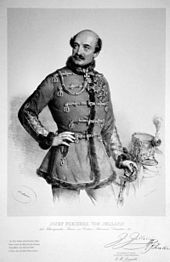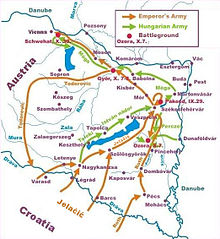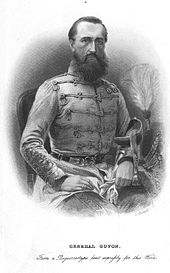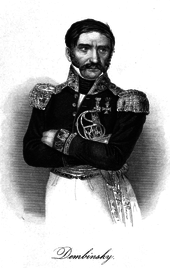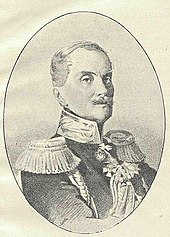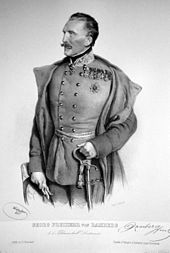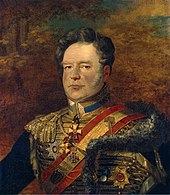Hungarian War of Independence

The revolution that broke out in Hungary on March 15, 1848 developed from October 1848 into Hungary's war of independence against the supremacy of the Austrian Habsburgs . The military successes in the first half of the war were extremely changeable for the two opponents. The doubling of the opposing number of troops from May 1849, caused by the intervention of the Russian army on the side of the Austrians , ultimately led the well-managed Honved army to defeat. As a result of the Hungarian surrender in August 1849, the victors faced severe reprisals, and the defeat in this war became a national trauma for the Hungarians.
Pákozd - Schwechat - Košice - Mór - Piski - Mediasch - Kápolna - Hatvan - Tápió Bicske - Isaszeg - Waitzen I - Nagy-Salló - Komorn I - Mocsa - Kács - Pered - Raab - Ács (Komorn II) - Komorn III - Hegyes - Waitzen II - Tura - Sighișoara - Debreczin - Szöreg - Temesvár
Arad - Deva - Esseg - Karlsburg - Komorn - Leopoldov - Oven - Peterwardein - Temesvár
The March Revolution and its Consequences
At the beginning of the March Revolution in 1848 in the Austrian Empire , Lajos Kossuth demanded in a speech written on March 3, 1848 the constitutional transformation of the monarchy and constitutions for the Austrian states. This speech was read out by Adolf Fischhof at the Estates meeting in Vienna . The attempt to deliver a petition to Emperor Ferdinand I turned into a real demonstration; the order to fire from Archduke Albrecht claimed the first deaths. On March 13, 1848, a revolution broke out in Vienna against the surveillance system of Prince von Metternich . Emperor Ferdinand I had to recall his chancellor before this pressure and promised a constitution.
On March 15, 1848, mass demonstrations also followed in Pest and Buda (Ofen). An existing assembly of estates based in Pressburg was to be converted into a parliamentary representation and an independent government set up in Hungary. A non-violent mass demonstration had forced the imperial governor Palatine Archduke Stephan to accept the conditions of the Hungarian revolutionaries, which among other things demanded freedom of the press , the abolition of censorship and forced labor . Lajos Batthyány was elected first Hungarian Prime Minister, Istvan Széchenyi became Minister of Transport , and the more radical Lajos Kossuth became Minister of Finance and chairman of a newly formed Defense Committee.
Ferdinand V was still allowed to call himself King of Hungary , but had to sign the new laws on April 11 in the Primate's Palace in Pressburg. The new government passed comprehensive state reforms, the so-called April or March Acts , which aimed to create a democratic state in Hungary. When the new government began its work, however, a strong Pan-Slav movement emerged at the same time, which ultimately sought to separate the Slavic parts of the country from the Kingdom of Hungary.
Uprising of the Croatians

Croatia , which until then had formed part of the Kingdom of Hungary, firmly rejected the Magyarization policy of the Hungarian revolution and gave the order to take appropriate action against it. In the emerging conflict between the national interests of the Serbs in the Banat and the Batschka , as well as with the Germans and Romanians in Transylvania , the Hungarian radicals saw in Pest the opportunity to mobilize the Landwehr and to set up their own army. In March 1848, General Joseph Jelačić was elected by the Croats to be Banus and commander in chief . He went to see the emperor who had moved to Innsbruck for recognition , but refused the oath as a banus and because of the changed relations between Hungary and Austria. On April 19, 1848, Jelačić , who was promoted to Lieutenant Field Marshal , declared his loyalty to Emperor Ferdinand and ended the union of Croatia with Hungary. The Viennese government wavered in its attitude towards Croatia and Hungary and initially rejected a separation of Croatia from Hungary. In the fortress Peterwardein commanded FML Hrabovszky von Hrabova (1779-1852) as commanding general of Slavonia , in mid-1848 he left for Pest and was appointed commanding general of Hungary. FML Jelačić had also convinced himself of the revolutionary mood that was fermenting in Vienna and returned to Croatia. In the conflict with the Hungarians he was able to rely on the support of the majority of the Croatian, Serbian, Slovak and Romanian rural populations. After Jelačić started his return journey to Agram , where his presence was urgently needed, he learned from newspapers during the trip to the Lienz station that he had lost all of his honors and dignities due to an imperial manifesto of June 10th.
In exuberant national feeling, the Magyars now waged wars against the non-Magyars in their kingdom: from June 1848 against the Serbs , then also against the Croats, Romanians, Slovaks, Ruthenians and Transylvanian Saxons. In a three-front war (against Jelačić's Croatian troops, in the Banat and in Transylvania), the Hungarian radicals saw Pest as a good opportunity to establish their full national sovereignty.
To secure their territory, the Croatians raised an army of around 80,000 of their own without asking for the approval of the Hungarian National Assembly. Serbian and Bosnian irregulars simultaneously threatened the Hungarian southern border. On June 11th, Kossuth gave a perfectly staged speech in the Hungarian Chamber of Deputies, in which he secured the provision of 180,000 soldiers and a budget of 42 million forints to protect Hungary's independence. Since revolutionary events were taking place again in Vienna, Austria first had to tolerate the new Hungarian government. But after the first phase of the revolution in Vienna could be suppressed, it refused to accept the new government.
For several months the new Hungarian government asked for support from the Habsburgs against the anti-Hungarian Ban of Croatia, and was even ready to send Hungarian troops to northern Italy against the uprising of the Italians . At the end of August, however, the imperial government in Vienna prohibited the establishment of a Hungarian army of its own. The mediation attempts between Hungary and Croatia also failed. Jelačić then began military actions against the Hungarian government without official orders.

Since the turmoil in the individual crown lands increased every day, Jelacic passed on September 11, 1848 45,000 men at Warazdin the Drava , a second column under the command of Major General Roth with another 10,000 men of the Slavonian banns the lower section of the river. The Hungarian Reichstag asked the Palatine Archduke Stephan to oppose the Croats at the head of the Hungarian army. In September the Hungarian government, in agreement with the Palatine, made further concessions to the radicals in order not to let the events degenerate into violent confrontations.
On September 12, Lajos Kossuth replaced the liberal Hungarian Prime Minister Batthyány. The position of the Palatine now became untenable both with the new national government and with the Austrian government. Archduke Stephan tried to negotiate with the Croatian Banus at Lake Balaton ; the meeting failed because of mutual distrust. On September 24, 1848, Stephan renounced his palatinate and fled to Vienna. The Palatine, however, obtained the appointment of his successor to the emperor: Count Georg Mailath (1786–1861) was appointed governor and Count Franz Philipp von Lamberg was appointed the new supreme commander of all armed forces in Hungary. Count Lamberg first went to Ofen to the newly appointed town commander General Hrabowsky and brought an imperial manifesto of September 22nd, in which Ferdinand forbade the recruiting of recruits to fight the Croatian-Slovenian associations. Prime Minister Batthyany supported Count Lamberg, who was born in Hungary and was well acquainted with the local conditions, and sought a compromise with the Croats. Kossuth vigorously opposed this policy and incited the people against it. There was a break between Vienna and Pest when Field Marshal Count Lamberg assumed command of all troops in Hungary (including those under Jelačić's command) on September 25th.
After a fatal attack on Count Lamberg at the ship bridge in Pest, the imperial court ordered the dissolution of the Hungarian government. A subsequent manifesto by the Austrian emperor declared the Hungarian Reichstag to be dissolved, imposed martial law on Hungary and now transferred the command of all Hungarian troops to the newly appointed Banus Jelačić. The war between Austria and Hungary officially began on October 3, 1848.
At the end of September General János Móga (1784–1861) was appointed Commander-in-Chief of the Hungarian Danube Army. The Croatian contingents under Jelačić were approaching Pest via Stuhlweissenburg at the end of September.
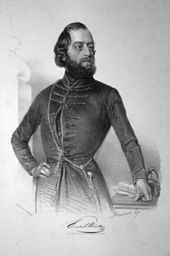
In the battle of Pákozd on Lake Velence on September 29, south-west of Ofen, the Hungarian insurgents and Jelačić entered into an undecided battle lasting several hours , which ended with the conclusion of a three-day armistice . A Hungarian brigade under General Artur Görgey was sent to the island of Csepel against the approach of the Banus Jelačić and united with the corps of Colonel Perczel (1811-1899). Together they forced the imperial troops under Major General Roth to surrender at Ozora on October 7th .
Vienna October Uprising
When insurgents attacked a barracks in Vienna, the crew of which was intended to support the Croatian troops, the October uprising broke out there . Arrived in Hungarian Altenburg , Jelačić received news of the murder of War Minister Theodor von Baillet-Latour by the rebellious Viennese on October 6th . Jelačić accepted the provisional armistice with the Hungarians and immediately moved on to Vienna. Half of his troops, 14,000 men under FML Thodorovich , he sent back home along the Styrian border as a precaution to protect Croatia.
The bloody events of October 6th in Vienna had aroused general indignation in Prague as well . As city commandant of Prague, Prince Alfred zu Windischgrätz had already successfully suppressed the Whitsun uprising in Prague in 1848 (in which his wife was killed). At his command two corps moved from Bohemia to Vienna to assist the beleaguered emperor and to put down the revolt there. By October 9, Windischgrätz had got the railway line between Prague and Lundenburg in his hands and thereby secured the transport and supplies of his troops. On October 10th, the Croatian outposts of Banus Jelačić also reached the Laaer Berge near Vienna, on the 12th they were united with the regular troops of Vienna under FML Count Maximilian von Auersperg .
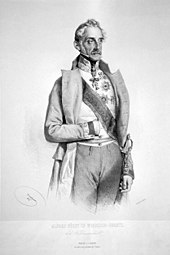
On October 15, Prince Windischgräetz was appointed field marshal and supreme commander of all imperial and royal troops outside Italy . On October 19, the prince moved his headquarters from Olmütz to Lundenburg, and three days later to Stammersdorf , where his army gathered. Other troops had crossed the Danube near Krems and arrived in Vienna from the west. On October 22nd the enclosure of Vienna was achieved, the I. Corps of Croats, which was under the Banus, was set up from Kaiser-Ebersdorf to Himberg to close the St. Marx line . The prince arrived at his headquarters in Hetzendorf on the 24th . The Banus now received all further orders directly from Prince Windischgrätz. Brigittenau was occupied on October 24th , and by the 27th the troops of the FML Ramberg division had advanced from the Au towards the Prater . Since October 14th, the Polish general Jozef Bem , who had entered Hungarian service, had also appeared in Vienna to take over the organization of the defense on the part of the insurgents. He took part personally in several skirmishes, especially the October 25 failure. October 28 broke, Field Marshal Windischgrätz continued the bombing and commanded the attack on the inner parts of the city from Laaerberg.
In the meantime the army of the Hungarian insurgents had passed the Leitha on October 28th and Fischa on the 29th . Towards the evening of October 29th, the imperial side saw the Hungarian columns under the command of General Móga on both sides of the road leading from Schwadorf to Schwechat , where they took up positions on the heights. On October 30th at around 9 a.m. the Hungarians had reached the positions of the Banus near Mannswörth and opened the fight with heavy gunfire. The strength of the Hungarians in the following battle near Schwechat was about 23,500 men and 71 guns. It was only towards evening that the Banus was able to repel the enemy attack through the intervention of a brigade under General Zeisberg .
On October 30, the insurgents in the town announced the apparent victory of the Hungarians at Schwechat; the commander in chief of the revolting National Guard , Messenhauser , broke the ceasefire and reopened hostilities. Windischgrätz's response was a heavy bombardment against the suburbs of Mariahilf , Gumpendorf and Wieden , which on October 31 brought him completely into possession of the capital. Windischgrätz had meanwhile increased to 33 battalions, 52 squadrons and 198 guns. After the imperial troops had brought the capital Vienna back under their control by October 31st, the main army was now sent to Hungary to eliminate the last threat to the empire. After the defeat at Schwechat, the defeated General Móga, the commander in chief, was replaced on November 15 by the more capable Brigadier Görgey, who was promoted to general at the same time.
The winter campaign of 1848/49
On December 2, the young Archduke Franz Joseph succeeded his uncle Emperor Ferdinand in the Reichstag in Kremsier and, after consulting with his Prime Minister Prince Felix zu Schwarzenberg , urged military action against the Hungarians. Windischgrätz launched his counterattack on December 15, 1848 to reverse the results of the Hungarian revolution of March 15. In the Vienna area his main army was formed in three corps : the 1st Corps under Jelačić, the 2nd Corps led by FML Lázló von Wrbna-Freudenthal and the 1st Reserve Corps Count Ferdinand Serbelloni , about 37,500 men and 6,000 horsemen, plus 800 pioneers and 238 guns. All together were now advancing eastward in the direction of Pressburg .
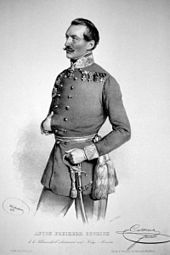
Under the command of Lieutenant Field Marshal Balthasar von Simunich , another 4,500 soldiers stood on the Moravian border and covered the left flank of the main army with garrisons in Tyrnau and Lipótvár . The Hungarian Danube Army had to go back to Wieselburg before the Austrian main army . On December 16, the extreme right wing of Windischgrätz was able to occupy Ödenburg , Görgey's army had already returned to Kapuvár .
At the Jablunka Pass , Lieutenant Colonel Carl Götz and 800 men kept in touch with the Slovaks who rebelled against Hungary . An 8,000 strong Austrian corps under General Franz von Schlick broke in from Galicia on December 6th over the Duklapass in northern Hungary, occupied Bartfeld and on December 9th Eperies without a fight. To stop silt, was a Hungarian Division under Colonel Alexander Pulszky zoom rushed and entrenched himself in defense of Kosice , south of Budamér , with strong power in advantageous height positions. General Schlick successfully attacked the 9,000 poorly equipped National Guards, Honvéds and Landstürmer and occupied Kosice on December 11th without further resistance. On the 15th, the Austrians met at Sziszko on Hungarian reinforcements brought in by the Minister of War General Lázár Mészáros . Schlick's troops held out, but had to retreat due to their numerical inferiority and suffered great losses due to the grim cold. When the numerical superiority was achieved, General Mészáros tried to recapture the lost Kaschau. At noon on January 4, 1849, he approached the attack with 18 battalions of Honvéds and National Guards , 1,000 hussars and 34 guns, but was thrown back by Schlick, with the Hungarians losing 10 cannons and 500 prisoners.
In the Batschka, in the Banat and in Syrmia , the imperial troops in Temesvár and Arad , the Serbs under the Woywoden Major General Stefan Suplikatz and the division of the FML Dahlen advancing from the Warasdin area prepared the advance towards Szeged and Kecskemét . FZM Laval Graf Nugent moved into southern Transdanubia from eastern Styria , and Major General Schneckl von Trebersburg began the siege of Esseg fortress .
The first phase of operations ended on December 27th with the capture of Raab by the imperial troops. While the main army under Prince Windischgrätz was marching on on Ofen-Pest , Jelačić had found out that a Hungarian insurgent corps under General Perczel with 8,000 men, 6,000 horsemen and 24 guns had assembled near Mór . Jelačić, placing himself at the head of the avant-garde, advanced on Sárkány and met the enemy on December 30, 1848 in the Bakony Forest . In the battle of Mór the cuirassier regiments Hardegg and Wallmoden split up the enemy center, the Banus waited for the Ottinger Brigades and the Hartlieb Division and proceeded to the main attack. The Hungarians suffered a heavy defeat and had to withdraw to Stuhlweissenburg .
At the end of December 1848, the Hungarian government gave up its capital, Pest, before the main imperial army marched and moved its headquarters to Debrecen . After the withdrawal of the Hungarians, another clash with the Croats on January 3, 1849 near Tetény also ended with the withdrawal of the insurgents. On January 4th the advance of Prince Windischgrätz began against the opposing capital. Görgey had built a line of defense between Pressburg and Ofen and had the strong fortress of Komorn occupied sufficiently, but withdrew with his core troops without a fight. At the side of Banus Jelačić, Prince Windischgrätz entered Pest on January 5th without a fight over the newly built chain bridge .
Fighting in the spring of 1849
Prince Windischgrätz contented himself with what had been achieved so far and remained in the garrison with 25,000 men in the furnace and 13,000 men in Pest for the next few months. In the battles at Windschacht and Schemnitz on January 12 and 21, 1849, Görgeys' Arriéregarde was blown up by the division under General Anton Csorich and part of its artillery was taken. In the south the imperial corps had united under FZM Nugent with FML Dahlen, left a crew in Körmend and advanced on January 4th via Zalaegerszeg to Kanizsa . The Serbian Woywode Suplikatz died unexpectedly on December 15th in Pancsowa ; General Thodorovich then took over his troops and took Werschetz on January 19 . On January 26th, the fortress of Arad was shot at by the Hungarians in vain; on January 30th a new attack by General Trebersburg's troops on Esseg was in vain. Feldzeugmeister Nugent occupied Kaposvár on January 19 and won Peterwardein by the end of the month , and in early February the Esseg fortress fell into the hands of the Austrians through treason.
The imperial III. Corps under General Schlick occupied the city of Tokaj on February 2nd with his division Schulzig . Görgey, meanwhile, used Schlick's march to retake Kaschau on February 10th , forcing Schlick to retreat to the west again so as not to get caught between two fires himself.
In the Battle of Kápolna on February 26th and 27th, General Henryk Dembiński had united three corps under General Görgey, Aulich and Klapka and attacked the Imperial II Corps under FML Wrbna. The Austrian brigade Colloredo had nailed the Hungarian division under General Pöltenberg in the forest of Vécs . In the evening the Schlick corps intervened in the battle from the north, united with the II Corps under FML Wrbna to 24,000 men and was able to force the Hungarians to retreat to Mezö-Kövesd .
Theater of war in Transylvania

In the south-eastern principality of Transylvania there was a real civil war between the Hungarians against the Romanians and Transylvanian Saxons residing there . The commanding general Anton Puchner had already placed the province under martial law on October 18, 1848; he had around 4,500 conscripts in the Sibiu area and attracted another 5,000 Romanians to reinforce it. Colonel Karl von Urban , loyal to the emperor, refused to obey the Hungarians; he remained loyal to the Habsburgs with 1,500 border guards and immediately tried to suppress the uprising of around 10,000 Szeklers in the Harghita area .
The beginning guerrilla war was characterized by attacks on the civilian population and was waged extremely cruelly by both sides. At the beginning of November strong Szekler units advanced on Saxon rain and plundered and pillaged the city; on November 5, Urban responded with cruel counter-actions at Radnót and Zalatna . Urban then turned to attack Cluj-Napoca . 3,500 Hungarians under Baldacci had rushed to the aid of the Szeklers, but were beaten and blown up at Szamos-Újvar . Major General Wardener then shot Cluj to rubble, and the city fell on November 18 without a sword blow. On November 21st, the Imperial Felvinc set fire to , the Szeklers plundered Marienburg in the Kronstadt district and laid Salzburg near Hermannstadt in ruins.
On December 19, 1848, Puchner was defeated by Bem at Dés ; the Hungarian advance on Sibiu was only successfully stopped on January 21st. The imperial forces were not able to cope with the tactical skills and guerrilla warfare of the opposing Commander in Chief Bem. After Puchner's call for help to Lüder's Russian corps in Wallachia , Engelhardt's division advanced over the Red Tower Pass to Sibiu. On February 4, 1849, Puchner was able to win the battle of Salzburg (Vizakna) and pushed Bem back on Mühlbach . In return, Bem was able to win the battle of Piski (February 9th) against the combined Austrian and Russian troops, he then pushed the imperial forces back through the Marostal to Reussmarkt after fighting at Alvinc .

At the beginning of March, Bems troops (5700 men, 820 horsemen, 30 artillery pieces) were defeated by Puchner's troops in the three-day battle near Mediasch and had to retreat to Schäßburg on March 4th . Bem drew reinforcements from the Szeklers and carried out another advance in the direction of Sibiu . While Puchner was chasing his opponent to Schäßburg, on March 14th he was able to occupy Sibiu, which was poorly covered by the Russian Sarijatin Brigade. After Bem was able to bring Kronstadt into his hand on March 19, Puchner was cut off from his rear lines and had to cross the border into Wallachia.
Transylvania had been lost to the Hungarians; an imperial garrison only remained in Deva for a short time . Karlsburg was included. At the beginning of May, the liberated Bems troops tried to unite with Perczel's troops in the Banat and to force the Serbs out of the Batschka . In October 1848 General Rukavina von Vidovgrad was ordered by the Hungarian government to hand over command of the Temesvar fortress to General Haller and to retire. Instead of obeying the order, he prepared the fortress for a siege and was then surrounded by the Hungarian revolutionary troops on April 23, 1849.
Turn of the war
The Austrian Prime Minister Schwarzenberg passed a state constitution on March 4, 1849, which degraded the Kingdom of Hungary to a crown land. In April and May in 1849 the fortunes of war turned visibly: Transylvania and large parts of the Banat were in the hands of the Hungarians; the main Austrian army on the Danube line lost important skirmishes and battles.
Seduced by the military successes, the Hungarian Diet declared on April 14, 1849 the complete independence of Hungary from the House of Habsburg-Lorraine and proclaimed the Republic. This manifesto now deprived the Hungarians of secure legal ground. Lajos Kossuth was declared Hungarian ruler with dictatorial power. Since Hungarian independence was not recognized internationally, most of the rest of the world either remained neutral or sided with the Austrian emperor.
The Banus Jelačić had received an order to march to Fényszaru in early April . On this march, the Croatian Rastić Brigade , which formed the rearguard, was attacked from three sides by the Hungarian General Klapka on April 4, but was able to assert itself successfully in the battle at Tápióbicske . At the same time, the Schlick corps ( Lobkowitz division and Liechtenstein division) had been repulsed by the Hungarian corps Damjanich and Gaspar in the battle at Hatvan until April 6, after being merged with the Csorich division .
On the march against Gödöllő , Jelačić and his corps arrived in Isaszeg on April 6th . At the same time Field Marshal Windischgrätz had advanced with the main force, but could not support the Banus sufficiently in the following battle near Isaszeg . The insurgents attacked the Croats with two corps under Klapka and Damjanich. The ban initially offered stubborn resistance, but eventually had to retreat to the nearby mountain heights. The victory at Isaszeg had been achieved by the Royal Hungarian Landwehr against the well-trained imperial troops. In the first battle of Waitzen on April 10, Waitzen was stormed by the Austrians. The imperial commander, Major General Christian Götz, fell .

On April 17th, the Hungarian main army under Görgey with 25,000 men (Corps Klapka and Damjanich) crossed the Hron near Kálna in order to free the occupation of Komorn. Too late a division under General Csorich was thrown against the Hungarians at Gran . The Wyss brigade was pushed to Párkány by the Hungarian 7th Corps under Major General Gaspar on Kéménd on the 19th . On April 19, Görgey was able to throw the isolated Austrian IV Corps under FML Wohlgemuth in the battle of Nagy-Salló (today: Tekovské Lužany ) and relieve the Komorn fortress by April 24 . While Görgey was hurrying to relieve Komorn, General Aulich entered the Pest, which had been cleared by the imperial army, on April 24th and was greeted with cheers by the population. Field Marshal Windischgrätz's weak leadership was so obvious after many defeats that he was recalled at the end of April.
The imperial main army, now led by the previous governor of Vienna, Feldzeugmeister von Welden , wrestled with the enemy in the First Battle of Komorn on April 26th and gave up the entire Danube line including the plague. An imperial garrison under FML Hentzi remained in Ofen (Buda) while the main forces were forced to retreat tactically. The Austrians withdrew behind the scales and back to Pressburg by April 27th. The Austrian troops were also driven out of Transylvania and the Banat by Bem and Perczel. Without completely defeating the Austrian army, however, the Hungarians halted their advance, trapped Ofen and prepared for their own defense.
Siege of Furnace

On May 4th, the Hungarians began the siege of Oven with 34,000 men and 133 cannons, which was defended by 3,500 Imperial soldiers with 51 cannons under Major General von Hentzi . The 3rd Corps under Karl Knézich marched between Kalvarienberg, Kis and Swabian Alb, and the 1st Corps under Josef Nagy-Sandor between the small Swabian Alb and the small Gellertberg . The section between the Little Danube and the Gellertberg was cut by the 2nd Corps under Lajos Aulich . The defenders under General Hentzi managed to repel 20 assault attacks by the rebels until the Hungarians were able to climb the walls on May 21, 1849. In these skirmishes Hentzi was fatally wounded and died 15 hours later; he had been able to withstand 17 days against 30,000 attacking Hungarians. Görgey lost two of his most capable leaders: General Aulich had left the army after taking Ofen as a result of severe suffering; General Damjanich was sidelined for two months because of an unfortunate broken leg.
Immediately after the fall of Ofen, the three army corps that had become free in front of Ofen were advanced via Gran to the left bank of the Danube towards the Lower Waag , and the separately operating division under György Kmety was directed to Stuhlweissenburg. The Hungarian 7th Corps under General Pöltenberg and its two divisions had been in front of Raab since the beginning of May; part of the Comorner crew on the same level on the Grosse Schütt . After Guyon's replacement, General György Klapka took over the Komorn fortress command. The 7th Corps maintained the positions at Raab. One part of the 8th Corps occupied Komorn, the other the line between Aszód and Szap on the Danube. The 1st Corps (Nagy-Sandor) had taken control of the Libra crossings at Freystadl and Schintau . The 2nd Corps (now under Colonel Lajos Asboth ) and the 3rd had advanced to Neuhäusel .
Operations of the Southern Army
In the meantime , Banus Jelačić, who had been promoted to Feldzeugmeister , became independent and was given the command of the Southern Army, consisting of his I Corps and the individual divisions operating on the lower Danube. This army numbered 15,800 men, 5,100 horsemen and 74 artillery pieces and, according to a previously agreed plan of operations, had moved along the Danube to Esseg on April 24th . The Hungarian southern army under General Mor Perczel had called in new troops to relieve Peterwardein in the spring ; from March 22nd he fought a victory at Zombor , later at Sireg and Horgos , then he strengthened the garrison of Peterwardein. In the northern Banat, the Hungarian 5th Corps under General Antal Vetter held the Austrian garrison in Temesvar under General Rukavina tightly since April 23 .
Kossuth's additional assurances that FML Bem would cross the Danube near Baja in the second half of April with 16,000 men were not fulfilled quickly enough. Bems troops did not reach Temesvar until the beginning of May, so that the Ban Jelacic could secure the right bank of the Drava unchallenged. In the second half of May, the Ban Jelacic advanced from Esseg (Osijek) via Wukowar , Ilok to Karlowitz , and moved into his headquarters in Ruma . The Hungarians reinforced the garrison in the fortress Peterwardein. FZM Jelačić had succeeded in strengthening his new southern army by the beginning of June: Without taking into account the occupation of Peterwardein, he had 33,000 men with 137 guns.
But when the exhausted regions of Slavonia and Syrmia could no longer provide food, the Ban began on June 5 to advance along the Franzenskanals and to occupy the line from Zombor to Bácsföldvár in order to re-establish contact with the main army. The next day the left wing was at Kaacs , the center behind the Kaacser Walde and the extreme right wing at Josefsdorf . A detachment was deployed against Kovil , and General Knićanin stayed behind to secure the plateau of Titel . In the battle near Kaacs on June 7, Jelačić pushed the so-called Bacs-Banat Army under Perczel (30,000 men with 88 guns) back and made a violent attack on their right wing. Croatian-Slavonian cavalry, hidden in the Kaacs forest, broke out of their hiding place and chased the enemy into flight. On the night of June 11th to 12th, the Ban attacked the entrenchments in front of Peterwardein, took them after a fierce battle and forced the crew to retreat quickly to the bridgehead. Peterwardein was included, the city of Neusatz was turned into a heap of rubble during this battle. When the Ban received news that an enemy corps was standing at Óbecse and was protecting the entrenchments and batteries on both banks of the Tisza at the bridge there, the Ban decided to attack this corps and began the night of June 24th to 25th near Szent Tamas the crossing over the Franzenskanal. On the morning of the 25th at half past eight, the Banus, who led the main column, encountered the enemy, forced him to retreat, advanced further and drove the enemy over the bridges at Obecse, both of which were immediately occupied by the troops loyal to the emperor.
On June 13, the Hungarian division under Kmety smashed the Austrian brigade under Major General Wyss near Csorna and united with Görgey's main power on the advance on Komorn. At the beginning of July Kmety was pushed south by the Austrians and caught up with Perczel's troops. On July 14th the battle took place at Hegyes , where the Hungarians under Perczel, advancing important detachments on his wings on the Danube and Tisza, were able to strengthen themselves considerably. Jelačić took his line-up at Kisbér , determined to stop the Hungarians. Even at the beginning of the fight, however, the first meeting of the Croatians was shaken. When the right wing gave way too, the Ban personally took the lead in the turnouts, addressed them in their mother tongue, held out, and recently led them towards the enemy, whom he then threw back as far as Szeghegy . Since, however, the insurgents became increasingly stronger and resistance to their growing masses became impossible, the ban was anxious to secure the line of retreat and also carried out the retreat in the best order. On that day, from 3 a.m. to noon, 7,000 men with 73 guns put up stubborn resistance on the side of the Banus to an enemy of well over 15,000 men with 100 guns.
The summer campaign of 1849
Takeover of command by Haynau

As a result of the successes of the Hungarians, Emperor Franz Joseph asked Tsar Nicholas I for military support, which he immediately followed. On May 17, 1849, FZM Welden in Vienna had its supreme command withdrawn and General Julius Freiherr von Haynau, who had been detached from Italy, had been given supreme command in Hungary. He was promoted to Feldzeugmeister and given unrestricted authority. By mid-May, a tacit ceasefire had been reached on both sides. When Haynau appeared on the Hungarian theater of war, the imperial army had taken a defensive position on the Waag and Danube.
By early June, Haynau had reorganized his army. The main army again consisted of four corps, the 1st Corps under General der Kavallerie Graf Schlick, the 2nd now FML Csorich , the 3rd Corps under FML Edmund zu Schwarzenberg , after the latter illness, FML von Ramberg took over the reserve -Corps (later IV. Corps) was under FML Ludwig von Wohlgemuth and covered the scales line. A Russian division under General Panjutin arrived in Tyrnau on June 1st and united with the Austrian main army at Pressburg on the 4th. On June 9th, the Perin Brigade of the Wohlgemuth Reserve Corps was able to prevent an attempt by the Hungarian 1st Corps to cross the Waag near Szered . On June 14, the Hungarian Danube Army began to cross the Waag, but the brigade under Major General Pott resisted at Zsigárd and, in cooperation with the division under Major General Herzinger, threw the enemy back towards Szered.
When FZM Haynau received the news that the main Russian power had already crossed the Hungarian border on June 17 and 18, 1849 and occupied Kosice, he ordered the advance on the Danube line to be resumed. Opposite Haynau, as before, stood the Hungarian Danube Army under Görgey with the 1st Corps under General Joseph Nagy-Sandor , the 2nd under Asboth, the 3rd under Kneszich and the Kmety division, as well as three weaker formations, a total of about 58,000 men with 229 guns.
Invasion of the Russian Army
From Poland, Bukovina and Wallachia , the Russian army with 130,000 men and 464 artillery under the Prince of Warsaw, Field Marshal Ivan Paskewitsch , broke into eastern and northern Hungary from three sides. On June 17, Paskiewitsch crossed the Hungarian border in three columns (II, III and IV Army Corps with 66,700 men) and, after several small skirmishes , advanced over the Duklapass to Kosice. General Dembinski, who stood opposite him, could hardly think of resistance with his widely dispersed 18,000 men. The imperial and Russian armed forces now available against Hungary amounted to a total of 275,000 men with 600 guns, which the Hungarians could only oppose a total of 135,000 men. Haynau largely avoided direct cooperation with the allied Russians in order to avoid the question of a unified supreme command. The division under Lieutenant General Panjutin , which was sent to him separately from Paskiewitsch via Cracow, was welcome as an important reinforcement.
Paskiewitsch had directed his thrust via Eperies and Miskolc to the Danube line, he was pushing back the Hungarian 9th Corps under the Polish general Jozef Wysocki and trying to squeeze his way between Görgey's army and the Austrians. On the right wing, the Grabbe Corps with 16,100 men covered the advance of the main army in the direction of the northern Waag via the Beskids and sought contact with the Austrians there via Neusohl .
The Russian General Grabbe received a request from the Austrian Minister of War to take action on the left bank of the Danube against Neutra in order to threaten the Hungarian garrison in Komorn from the north. The corps of General Osten-Sacken accompanied the Carpathian crossing of the main army in the east with its 8,700 men through its border incursion at Stryj as the left wing. Through the Bukovina , the independently operating corps under Lieutenant General von Grotenhielm with 8,200 men broke into Transylvania from the northeast .
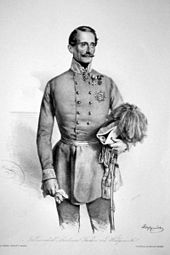
The Russian VI. Corps under Lieutenant General Lüders penetrated from Wallachia with 25,000 men from the south into Transylvania and advanced on Kronstadt . The Russian advance on the now open northern and eastern fronts of the Hungarians forced the Hungarians to further fragment their now numerically completely inferior armed forces and established a negative political relationship with the Tsarist empire for the future.
Görgey, who has now been appointed Hungarian Minister of War, was opposed to General Klapka's defensive plan for the main army and ordered a counterattack against Haynau despite the fact that the Russians were threatened by the Russians. With his dictatorial power of attorney, Kossuth had designated General Bem as the new Commander-in-Chief, but he was not available for the time being and was still far from the main theater of war in Transylvania.
The imperial army, reinforced by the 12,000-strong Russian Panjutin division, numbered around 66,000 infantry, 10,000 horsemen and 324 artillery pieces. As a result of the advance of the main Russian army, Feldzeugmeister Haynau acquired knowledge of the departure of the enemy Danube Army from Komorn. Haynau determined the II. Corps to maintain the siege of Komorn and advanced with the I. Corps and the (IV.) Reserve Corps, as well as the Panjutin Division, the III. Army corps advance as vanguard, against Ofen, where he assembled his army on June 19th.
On June 20, Haynau attempted the Waag Front, threatened by the approach of the Hungarian 2nd Corps (Asboth), by dispatching the Herzinger Division of the IV Corps (with 13,600 men, 1200 riders with 54 cannons) and the Russian division Panjutin ( 13,100 men). In the following Battle of Pered on June 21st, 27,900 Imperial and Russians with 102 cannons faced around 19,100 Hungarians with 85th cannons. The Austrian victory was fought primarily through the Wohlgemuth corps. The imperial II Corps (12,000 men, 900 horsemen and 42 cannons) had started to surround it via Serega-Akol. The Hungarian 3rd Corps under General Leiningen-Westerburg was attacked in Pered by the Russians and the Austrian Pott Brigade (Herzinger Division). The intervention of the Hungarian 8th Corps (10,100 men under Major General Kostztolonyi) pushed the Theissing Brigade out of Királyrév . The Pott brigade had to withdraw via Deáki , the Theissing brigade via Szellye . The Hungarians occupied Pered, but were thrown back on Negyed on June 21 by the forceful intervention of Panjutin's division and went back over the Waag. The defeated Hungarian 2nd Corps lost 2602 men and 4 guns, the less involved 3rd Corps lost 518 men, a total of 3,120 men.
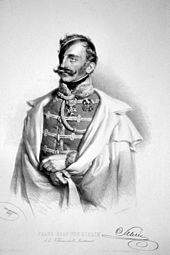
On June 26th, the young Emperor Franz Joseph joined the army in Hungary, and on that day FZM Haynau issued the order to his troops from his headquarters in Hungarian-Altenburg to resume the advance.
On June 27th Haynau changed the bank of the Danube and advanced on Raab, where on June 28th he attacked the Hungarian Division Kmety and the enemy 7th Corps under General Pöltenberg with superior strength and was able to drive them out. A final conference of the Hungarian government was held in Pest on June 29th in its official capital. Görgey's idea to continue the offensive against Haynau was finally given up because of the Russian invasion through Kossuth.
On June 28, the imperial army advancing on the right bank of the Danube attacked the Raab fortress with the I. and III. Corps and the Reserve Corps, while the II. Corps operated on the left bank in the Schütt . The attacks by the Schlick Corps forced the Hungarian occupation to retreat against Ács , and in the afternoon the imperial army was able to move into Raab.

General Carl Vecsey (1806–1849) with the 5th Corps was appointed to conquer the fortresses of Arad and Temesvar . Until July 1849, the fortress of Arad was under the Austrian general Johann Nepomuk Berger , when Arad was taken by the Hungarian rebels, who made it their headquarters in the later course of the revolt . FML Rukavina was trapped in the fortress on April 25 with 8,800 men and, due to disease and hunger, had only 5,600 men left.
Fight at Komorn
After taking the Raab fortress (June 28), FZM Haynau concentrated the main Austrian army near Komorn . He gathered about 42,400 men, 7,300 horsemen, supported by 176 cannons, but about 16,000 men could not be directly deployed because of an epidemic. The attack on Komorn began on June 30th, General Klapka defended the fortress with over 36,000 men, he commanded the 3rd, 7th and 8th Corps under the Generals Leiningen-Westerburg, Pöltenberg and Aschermann . The Hungarians had already withdrawn behind strong entrenchments; only on the left wing of their position did they leave the town of Szőny heavily occupied. The Austrian I. Corps advanced from Ács and Lovad against Komorn. On July 1, Haynau also had his reserve corps from Igmánd via Puszta-Csém , to the right of which the Bechtold cavalry division and, behind it, the Russian Panjutin division. In order to fight his way to Stuhlweissenburg, Görgey tried again to break out of the fortress. The fight of the Hungarian 1st Corps took place again for the possession of the forest of Ács. After the Battle of Ács on July 2, both opponents returned to their starting positions after a tough tough fight.
On July 3, Haynau began another attack on the Komorn Fortress. The Third Battle of Komorn , planned by General Joszef Bayer, Görgey's Chief of Staff, for July 9th had to be postponed to July 11th due to waiting for supplies. Since Görgey was not yet fit for duty because of wound fever, the control of the fight was in the hands of General Klapka. This led his main attack without reserves and scattered his forces all along the line. Baron Haynau had his Herzinger division, which was advancing from Puszta-Csém against Puszta-Harkály, and the Russian division Panjutin, advancing from Igmánd, to the right of Csém, intervened in the battle. By around 5 p.m. the Hungarians were thrown on all points and had to retreat back into the fortress. On the same day the Austrian Major Wussin and his detachment moved into Ofen, while the Cossacks under Colonel Graf Adlerberg had arrived in Pest at the same time and made contact with the Austrians. FML Ramberg followed on July 12th with his division and took formal possession of Buda-Pest . The Hungarian government, who had fled Pest, brought its banknote press to Szegedin on the Tisza, where Haynau initiated the persecution.
On July 6th, Generals Aulich, László Csányi and Ernő Kiss were sent from Kossuth to Komorn to persuade Görgey to retreat. The Hungarian main army (24,035 infantry, 4,019 cavalry and 137 artillery pieces) left the Komorn Fortress with three corps (I., III. And VII. Corps) in the course of July 13th and withdrew on the Tisza in the direction of Szegedin , where the Hungarian government now had its seat. General Klapka remained in Komorn with 18,260 men (II and VIII Army Corps), 48 field guns and 350 fortress guns, Görgey withdrew with his main force to Vác (Waitzen).
Operations of the Paskievich Army
In July 1849 there were already strong Russian formations on Hungarian soil, which far outnumbered the Hungarian army. After his withdrawal from Komorn, Görgey's armed forces comprised 33 battalions, around 43 squadrons and 130 artillery pieces. He tried to break through via Waitzen and Gödöllő against Cegléd in an eastward direction to the Tisza, with General Perczel's army to support with an attack in the direction of Aszód .
Meanwhile, on July 16, Haynau entered Pest, which had been abandoned without a fight, and his army took up positions on the Rakosbach. He decided to quickly continue the operations on the Tisza. Even if Görgey succeeded in advancing eastwards to Gödöllő via Waitzen, the intervening Russian III. Corps strong enough to hold him in place until the Russian 2nd and 4th Corps were able to push Perczels back. In this case, the Austrian III. Army Corps (FML Ramberg) approached early enough to advance from the Pest area against Gödöllő to the right flank of the Hungarians. At 10 o'clock in the morning the 1st Insurgent Corps (Nagy-Sandor) arrived in front of Waitzen and occupied it with infantry and took up an advantageous position with its cavalry and guns in front of Waitzen, the right wing leaning against the Danube river, the left against Waitzen.
The Russian Lieutenant General Sat, the vanguard of III. Forming a corps, on July 15, 8 battalions and 16 squadrons, later reinforced by a cavalry brigade of the 2nd Army Corps, rushed towards Waitzen and attacked the Hungarian position at 2 p.m. After a fierce gun battle General Saß gained some advantages, around 3 p.m. the Hungarian 3rd Corps (Leiningen-Westerburg) also arrived in Waitzen. When the rest of the troops under General of the Cavalry Count Fyodor Rüdiger (1783-1856) arrived from Hatvan , he was able to hold onto the main Hungarian power until the other two corps were approaching. On the afternoon of July 15, Paskievitsch himself advanced with the II Army Corps from Hatvan via Acsa and opened the three-day battles at Waitzen .
On July 16, however, the Hungarian 7th Corps under General Ernő Pöltenberg had also arrived at Waitzen, where forces of roughly equal strength were now facing each other. Instead of attacking with all his might, Görgey stayed in and in front of Waitzen to allow his troops, exhausted after three days of march, a rest day. On the night of July 16-17, Görgey set out from Waitzen to rescue his army, which had been caught up in front and back, north towards Debrecen. Leiningen and the 3rd Corps at Waitzen provided cover for this retreat. The main Hungarian army assembled near Szegedin, now again under the command of the Pole Dembinski, withdrew to the left bank of the Tisza after Haynau's approach.
The Hungarian Tisza Army under Perczel held the following positions on July 16 and 17: The 9th Corps was at Abony , the 10th Corps also held one division at Abony, the others at Szolnok . The division under General Knezich on the other side of the Tisza was advanced to Tokaj , where fortifications began. The important Greater Oradin was covered by reserve troops. At dawn on July 17th the Hungarian 7th Corps took up position to front against the Russians. The Russian cannon fire brought Pöltenberg's battalions considerable losses. A daring Cossack attack on Waitzen put part of the Leiningen corps in danger of being cut off. After a utter confusion, Görgey appeared, himself suffering from a head wound, and restored order in his ranks and in the retreating units.
Paskiewitsch had the general approach of the Russian III. Army corps ordered against Waitzen. In the evening Görgey took up a position on the heights behind the town of Rétság and was attacked by the Russian division under General Anrep . The Leiningen corps followed the main force on the road to Balassagyarmat . General Rüdiger followed with the bulk of III. Corps after, the Russian II Corps stopped in Waitzen. Meanwhile the Grabbe corps had also been ordered to join the main army on the shortest line. General Grabbe was from July 19 Altsohl broken up and marched across Szenograd and Kekko to Balassagyarmat ago, but returned on 21 with his corps to Altsohl back to from there better ways to more quickly Losoncz to advance. Behind Losoncz, Grabbe suddenly crashed into the outposts of the Hungarian 1st Corps under Nagy-Sandor. The Arriere Brigade under General Chrulyov saw about 9,000 men with 40 guns in front of them and put him to fight on July 20. He won the battle at Tura on the 20th , again on July 24th at Görömböly and on the 25th at the Sajó river , pushed the enemy rearguard to the Theiss and took Debrecen on July 28th .
The Russian V Corps under General Lüders was operating very successfully in Transylvania against General Bem, who had to retreat towards Sibiu with 14,000 men and 26 cannons. General Lüders arrived in Gálfalva , from where Bem had set out for Medias . A Russian brigade under General Hasford had previously appeared in Sibiu , but withdrew to Talmesch after Bems approached , in order to remain there until the main forces arrived.
On July 23, Görgey's headquarters were in Alsózsolca , not far from Miskolc . After the unsuccessful attempt to reach Miskolc before Görgey, the Russian IV Army Corps under General of the Infantry Cheodayev remained in Ábrány until July 24th and united with the troops of General Grabbe in the following days. On July 24th, the Russian IV Corps set off from Ábrány via Harsány and attacked the remaining parts of the Hungarian 7th Corps, which after a few cannon shots gave up their position on the left bank of the Sajo.
Paskiewitsch had initiated the advance of his army on Debrecen from Tiszafüred until he received the news that Görgey had occupied Miskolc again. The prince decided to postpone the procedure to Debrecen for the time being and let his II. And III. Army Corps advance to Csege on July 29th . So that at the same time standing closer to the IV Army Corps, which was located at Csát and which was covering from Miskolc against the Tisza, the Russian field marshal was lord of both banks of the Tisza. On July 30th, Görgey had to give up his position and retired to Tokaj .
Sent to restore the lost connection to the corps Grabbe Paskiewitsch the Division of General GLASENAPP about CSAT to Papa to support IV. Corps to the right bank of the Tisza. After the Osten-Sacken corps had successfully occupied Tokaj , Paskievitsch saw his rear lines sufficiently strengthened, and pulled the bulk of his troops to Csege in order to proceed again against Debrecen.
On July 31, the Grabbe Corps tried to get in touch with the Osten-Sacken Corps advancing from Kaschau and advanced from Putnok to Edelény . The Russian III. Corps - combined with the Grabbe Corps, which for this purpose remained between Miskolc and Rima-Szombath - as well as the reserve corps of General von Osten-Sacken, a force of 76 battalions, 72 squadrons, altogether about 55,000 men and 6,000 over the Carpathians Horsemen with 250 guns would have been enough to force Görgey's exhausted insurgent army, barely 24,000 strong, to lay down their arms on the Sajo - but a cholera had significantly decimated the troops. Paskiewitsch wanted to advance via Debrecen to Großwardein and establish contact with the Austrian army, from which the 1st Army Corps had already passed over to the left bank of the Tisza on August 1st and operated against the Maros . The Osten-Sacken corps remained at Tokaj to cover the crossing and received orders to enclose Munkács and advance to the sources of the Tisza.
In Transylvania, meanwhile, on July 31, the three times superior Russian General Lüders (14th and 15th divisions with 20,800 men and 56 cannons) defeated General Bem's troops (6,800 men and 12th cannons) in the battle of Schäßburg ( Segesvár ). Bem escaped capture with little difficulty in the direction of Großwardein and on August 8 was given supreme command of the southern army defeated at Szőreg on August 5 , which in turn retreated to Temesvar.
Haynau's advance to the Tisza and south of the Maros
On July 22nd, Feldzeugmeister Haynau opened his summer campaign in the direction of Szeged , where the Hungarian revolutionary government met until July 28th. The Austrian III. Army Corps (FML Ramberg) moved from 23 July on Soroksár, Laczhaza and Szent-Miklos to 29 July after Mélykút ago. The Austrian IV Army Corps, now under the command of FML Prince Franz de Paula von und zu Liechtenstein , did not set out from Pest until July 24th, reached Cegléd on the 26th and pushed its avant-garde brigade Benedek to Abony . Haynau's I. Corps had meanwhile occupied Kecskemét .
Threatened by the Austrian march, the Hungarian government relocated its headquarters further east on July 28, to the fortress of Arad am Maros, which was conquered at the time. To pursue the enemy, Haynau also called in the I. Corps of Komorn, which arrived in Abony via Pesth and Cegled and occupied Szolnok on July 30th .
A patrol corps further south under Colonel Althann advanced from Baja to Maria-Theresiopel on July 30th , occupied the city without a fight and united in Kanizsa with the advancing Corps Ramberg.
On July 29th, Haynau set up his headquarters in Felegyhaza, where he and the bulk of his troops were preparing the attack on Szegedin. During the advance, the I. Corps covered the left flank at Czibakhaza under Schlick, the III. Corps was advancing on Old Kanizsa via Maria Theresiopel. The IVth Army Corps of Prince Lichtenstein was forwarded in the direction of Szegedin; Panjutin's division followed with the artillery reserve in the same direction and stood at Klarafalva.
On August 2nd, Szeged, which the Hungarians had evacuated without a fight, was occupied by the Austrian troops. Haynau had with the III. Corps (Ramberg) forced the Tisza crossing at Kanisa on August 3, the Panjutin division and IV. Corps (Liechtenstein) had already crossed the river at Szegedin on August 4.
On August 3, in the hinterland, the weak Austrian Zernierungscorps off Komorn on Puszta-Harkaly was thrown back by a failure of Klapka; two brigades withdrew to Pressburg, one to Pered, and Komorn was once again defeated. The Hungarians even briefly occupied Raab and grazed both banks of the Danube. While the main mass of the insurgents in Eastern Hungary were approaching their downfall, Feldzeugmeister Count Nugent pulled his 2nd Reserve Corps, around 9,000 men, over Stuhlweissenburg to Komorn. At the end of July, the imperial southern army under the Banus Jellacic had also forced the area north of Szlankamen to support Haynau, a division of his corps had stayed behind to further separate Peterwardein. The new camp was moved to Vilova and Titel, a division under FML Dietrich held a bridgehead with three brigades on the western bank of the Tisza.
On August 5th, Haynau and his IV Corps met the Hungarian Army of the Tisza in the battle of Szöreg . The Hungarian army, about 33,000 strong, now under the command of General Dembinski, had given up the west bank of the Tisza. The Hungarian 10th Corps under Dessewffy and the Polish Legion under Wysocki were bypassed and thrown back. The I. Corps under Count Schlick had crossed the Maros at Makó on August 4th and appeared in the rear of the Hungarians who had been defeated at Szöreg . Panjutin pursued the Hungarian 9th Corps under General Gal on southern Maros via Deszka.
Meanwhile, Haynau advanced with 28,000 men, 6,600 horsemen and 192 guns to relieve Temesvar further south-east. To cover the northern flank against Arad and Großwardein, Count Schlick's I. Corps had to advance in the Maros Valley as far as Arad and maintain level with the IV Corps advancing in the center. On the south wing the III. Corps under Ramberg the push over Banat-Komlos and covered against weak Hungarian formations under General Kmety.
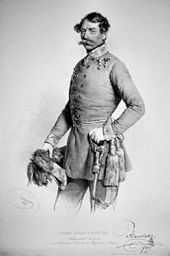
Once again the Hungarian army tried to hold out in positions northwest of Temesvar. On August 9, Haynau was victorious in the battle of Temesvár , the Hungarians under Bem and Dembinski had 54,000 men, 10,000 of whom were militiamen. The vanguard of the Imperial IV Corps (Prince of Liechtenstein) had advanced with the cavalry division under General Wallmoden via Knec and Hadony. The imperial III. Corps under FML Ramberg and the Russian Panjutin Division with a reserve of 12,000 men took up position at Kis Bescherek. The Hungarian 5th Corps under General Vecsey maintained the siege while Bem attempted the counter-attack with the main force. On the left wing the Kmety division was deployed at Szakalhaz, the 4th Corps under Richard Guyon in the forest of Csok, in the center the Corps under Gal, on the right wing the 10th Corps under Dessewffy. The entire front was covered by the Nyaradbach, Bems advancing artillery initially kept Haynau's battalions at a distance, but then suffered heavier losses due to the stronger fire control of the Imperial forces under Major General Hauslab . At around 4 p.m. at Szt. Andras opened 24 guns of the Herzinger division and decimated the line of the Hungarian militias. Bems army began to disintegrate without much infantry fighting, the remnants flee to Lugos . The rest of the indignation was suppressed and the imperial garrison, besieged in Temesvár, liberated.
Görgey's army, meanwhile pursued by the main Russian forces, tried to unite with the defeated Bem and Dembinski at Lugos at Temesvár. Count Schlick's troops, however, thwarted this plan by driving back the Hungarian avant-garde sent out from Arad at Dreispitz on August 10th . The Russian division Panjutin already received orders to leave the Austrian main army and to bring his division to Arad to meet with the III. To unite corps under Count Rüdiger. After Haynau's victory at Temesvár, the Banus occupied Pancsova and on August 16 reached communication with Haynau's main army in Új-Pécs .
Surrender of Vilagos
After there were no more Hungarian troops on the right bank of the Upper Tisza, Paskiewitsch took General Saß's detachment and the bulk of the IV Army Corps to himself, but part of this corps remained on the right bank of the Tisza under the command of General Osten-Sacken back. General Cheodayev and his troops advanced to Korom on July 31, and to Szerenes and Zombor on August 2, and took position not far from Tokay. Thereupon he pushed his vanguard on the left bank of the Tisza against Nyíregyháza in order to achieve the connection with Paskiewitsch near Debreczin. The Grabbe corps was ordered back to north-west Hungary on August 3rd and returned to Altsohl on August 10th . The Russian Corps under General Grotenhjelm had Cluj taken and moved further on Sibo, the Hungarian detachment of Kazinczy pursuing.
Görgey and the rest of his main army had marched down the left bank of the Tisza to Arad to cover the new seat of government. After all the calls to other European powers were unsuccessful, Kossuth abdicated on August 11th in favor of Görgey, who he assumed was the only general capable of saving the nation. Görgey received the dictatorship, but desperate to continue the resistance and made the decision to surrender to the Russians and not to the hated Austrians. Already on August 13th, Görgey with 11th generals, 1,426 officers, 20,000 infantry, 2,000 cavalry and 129 guns in the Vilagos village in front of the Russian troops under General Rüdiger surrendered his weapons and handed over his army.
Final act of the war
A small remnant of the Hungarian army with 4900 officers and soldiers under the leaders Bem, Dembinski and Perczel saved themselves by crossing over to Turkish territory. Lajos Kossuth buried the Hungarian coronation insignia near the Danube near Orsova and also escaped capture. On August 16, the corps under Colonel Kazinczy with 10,000 men surrendered, on August 17 General Damjanich surrendered the fortress of Arad, and on September 7 the surrender of Peterwardein finally followed. Only the strong fortress Komorn, where the 2nd Reserve Corps under FZM Nugent took over the command of the siege on September 1st, held out under General Klapka. He only initiated handover negotiations with Haynau on September 29 and achieved an honorable surrender on October 2. Feldzeugmeister Haynau remained governor of Hungary for a few months and on October 6, 1849 ordered the execution by hanging the 13 martyrs of Arad .

Lajos Batthyány had already been captured in the middle of the war and was shot dead in Pest on the same day under heavy pressure from Haynau .
At the end of August, Ban Jellacic was appointed to the imperial court camp in Vienna and involved in the deliberations on the reorganization of Croatia, Slavonia and the military border, because he had precise knowledge of these countries and was able to have a decisive say in them. Archduke Albrecht von Habsburg was appointed governor of the Kingdom of Hungary by the emperor and carried out a political transformation of the country. It was not until the settlement with Hungary in 1866 that the defeated nation gained a little more autonomy.
literature
- Anatole Wacquant: The Hungarian Danube Army 1848–49. Silesian book printing, art a. Publishing house v. S. Schottlaender, Breslau 1900.
- Rudolf Kiszling : The revolution in the Austrian Empire. Volume 2, Universum Verlag, Vienna 1948/49.
- Wilhelm Pütz : The Hungarian Revolution. Based on Anton Springer from The History of the Last 50 Years 1816–1866. Dumont-Schaubergscher Verlag, Cologne 1867, pp. 401-416.
- Alfred Prince of Windisch-Grätz: The winter campaign 1848–1849 in Hungary. Leopold Sommer bookstore, Vienna 1851.
- Artur Görgei: My life and work in Hungary in the years 1848 and 1849. FA Brockhaus Verlag, Leipzig 1852.
- Alois Carl Wiesner: The campaign of the Hungarians against the Austrians and Russians 1848/49. Leonhard Hitz, Chur 1853.
- Wilhelm Rustow : History of the Hungarian War of Insurrection 1848 and 1849. Friedrich Schultheß Verlag, Zurich 1861.
Individual evidence
- ^ Johann Mailáth : History of the Magyars Vol. 5, G. Joseph Manz Verlag, Regensburg 1853, S. 5 f.
- ^ Anatole Wacquant: The Hungarian Danube Army 1848-49, Breslau 1900, pp. 2–10
- ^ Anatole Wacquant: The Hungarian Danube Army 1848-49, Breslau 1900, p. 20
- ^ Anatole Wacquant: The Hungarian Danube Army 1848-49, Breslau 1900, p. 52 f.
- ^ Oesterreichisches Militär-Conversations-Lexikon , pp. 555-560
- ^ Johann Mailáth: History of the Magyars Vol. 5, G. Joseph Manz Verlag, Regensburg 1853, p. 116
- ^ Anatole Wacquant: The Hungarian Danube Army 1848-49, Breslau 1900, p. 131 f.
- ↑ János Czetz: Bem's campaign in Transylvania, Hoffmann and Campe, Hamburg 1850, p. 249 f.
- ↑ Isaszeg map. Retrieved December 12, 2014 .
- ^ Anatole Wacquant: The Hungarian Danube Army 1848-49, Breslau 1900, p. 158
- ^ Johann Mailáth: History of the Magyars Vol. 5, G. Joseph Manz Verlag, Regensburg 1853, p. 217
- ^ Johann Mailáth: History of the Magyars Vol. 5, G. Joseph Manz Verlag, Regensburg 1853, p. 220
- ↑ Anatole Wacquant: The Hungarian Danube Army 1848-49, Breslau 1900, p. 174 f.
- ^ Anatole Wacquant: The Hungarian Danube Army 1848-49, Breslau 1900, p. 202 f
- ↑ Anatole Wacquant: The Hungarian Danube Army 1848-49, Breslau 1900, p. 213 f
- ^ Anatole Wacquant: The Hungarian Danube Army 1848-49, Breslau 1900, p. 220 f.
- ^ Anatole Wacquant: The Hungarian Danube Army 1848-49, Breslau 1900, p. 249 f.
